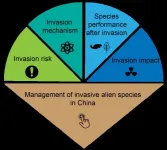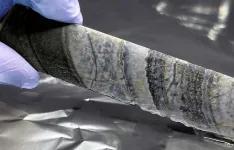Accelerating rates of biological invasion have led to growing concerns about the destructive impacts of invasive alien species, or IAS, on the environment and human societies. This is especially true in China, which has witnessed a surge in research investigating the causes and consequences of these invasions.
“This collection came about because of the growing research interest in biological invasion in China, and the priority our government has given this issue,” said Xuan Liu, Professor with the Chinese Academy of Sciences’ Institute of Zoology and one of the Special Feature’s four Guest Editors, along with Wei Huang, Yanjie Liu and Aibin Zhan. “I am very pleased to share this collection of innovative studies from Chinese colleagues addressing the risks, mechanisms, performances, and impacts of invasive alien species in China, which are helpful for the development of effective control and mitigation strategies.”
The 24 articles that comprise the collection cover a wide range of organisms, from vertebrates and plants to freshwater mussels, snails and oysters. The research tackles critical questions like whether genetics can explain some IAS success; how nutrient pollution from fertilizers, sewage and the like affects IAS; and the availability of invasive plants for sale online in China.
“I think the collection as a whole offers valuable insights into the future of basic and applied biological invasion research coming out of China,” said Ecological Applications’ Editor-in-Chief Juan Corley. “These articles showcase a real diversity of methods and approaches, which will be needed to address the worrying problem of invasive species in China, particularly in the context of continued globalization.”
Chinese translations of most of the articles’s abstracts are available. A Chinese-language summary of the Special Feature accompanies the collection.
Articles:
INTRODUCTION: Perspectives of invasive alien species management in China
Xuan Liu, Wei Huang, Yanjie Liu, Aibin Zhan
eDNA-based detection reveals invasion risks of a biofouling bivalve in the world's largest water diversion project
Zhiqiang Xia, Junnong Gu, Ying Wen, Xinkai Cao, Yangchun Gao, Shiguo Li, G. Douglas Haffner, Hugh J. MacIsaac, Aibin Zhan
High-latitude invasion and environmental adaptability of the freshwater mussel Limnoperna fortunei in Beijing, China
Congcong Wang, Mengzhen Xu, Jiahao Zhang, Xiongdong Zhou
Vulnerability of protected areas to future climate change, land use modification, and biological invasions in China
Yusi Xin, Zhixu Yang, Yuanbao Du, Ruina Cui, Yonghong Xi, Xuan Liu
Cultivated alien plants with high invasion potential are more likely to be traded online in China
Ran Dong, Bi-Cheng Dong, Qiu-Yue Fu, Qiang Yang, Zhi-Cong Dai, Fang-Li Luo, Jun-Qin Gao, Fei-Hai Yu, Mark van Kleunen
Clonal functional traits favor the invasive success of alien plants into native communities
Yong-Jian Wang, Yuan-Yuan Liu, Duo Chen, Dao-Lin Du, Heinz Müller-Schärer, Fei-Hai Yu
Population genetic differentiation and phenotypic plasticity of Ambrosia artemisiifolia under different nitrogen levels
Yunqi Xiong, Ayub M. O. Oduor, Caiyun Zhao
Transgenerational plasticity in morphological characteristics and biomass of the invasive plant Xanthium strumarium
Xinyue Liu, Xiaozhen Man, Meishan Chen, Changxin Zhao, Chuang Liu, Jialin Tong, Fanqi Meng, Meini Shao, Bo Qu
(Epi)genomic adaptation driven by fine geographical scale environmental heterogeneity after recent biological invasions
Yiyong Chen, Ping Ni, Ruiying Fu, Kieran J. Murphy, Russell C. Wyeth, Cory D. Bishop, Xuena Huang, Shiguo Li, Aibin Zhan
Multiple genetic sources facilitate the northward range expansion of an intertidal oyster along China's coast
Li-Sha Hu, Yun-Wei Dong
No evidence that modification of soil microbiota by woody invader facilitates subsequent invasion by herbaceous species
Yan Li, Xingliang Xu
Enhanced mutualism: A promotional effect driven by bacteria during the early invasion of Phytolacca americana
Yunhao Meng, Xinze Geng, Ping Zhu, Xinfu Bai, Ping Zhang, Guangyan Ni, Yuping Hou
Opposite effects of nutrient enrichment and an invasive snail on the growth of invasive and native macrophytes
Yimin Yan, Ayub M. O. Oduor, Feng Li, Yonghong Xie, Yanjie Liu
Disentangling the role of environmental filtering and biotic resistance on alien invasions in a reservoir area
Haichuan Le, Changming Zhao, Gaoming Xiong, Guozhen Shen, Wenting Xu, Ying Deng, Zongqiang Xie
Tidal channel meanders serve as stepping-stones to facilitate cordgrass landward spread by creating invasion windows
Zhonghua Ning, Baoshan Cui, Cong Chen, Tian Xie, Weilun Gao, Youzheng Zhang, Zhenchang Zhu, Dongdong Shao, Dongxue Li, Junhong Bai
Biotic resistance to fish invasions in southern China: Evidence from biomass, habitat, and fertility limitation
Dangen Gu, Tao Jia, Hui Wei, Miao Fang, Fandong Yu, Lu Shu, Xuejie Wang, Gaojun Li, Xingwei Cai, Xidong Mu, Meng Xu, Jianwei Wang, Yinchang Hu
Nutrient enrichment promotes invasion success of alien plants via increased growth and suppression of chemical defenses
Liping Shan, Ayub M. O. Oduor, Wei Huang, Yanjie Liu
Effects of nutrient pulses on exotic species shift from positive to neutral with decreasing water availability
Evans O. Otieno, Changchao Shen, Kaoping Zhang, Jinlong Wan, Minyan He, Zhibin Tao, Wei Huang, Evan Siemann
Fluctuations in resource availability shape the competitive balance among non-native plant species
Zhibin Tao, Changchao Shen, Wenchao Qin, Baoguo Nie, Pengdong Chen, Jinlong Wan, Kaoping Zhang, Wei Huang, Evan Siemann
Polyploidization-enhanced effective clonal reproduction endows the successful invasion of Solidago canadensis
Dongyan Feng, Jiliang Cheng, Xianghong Yang, Zhongsai Tian, Yujing Liu, Yu Zhang, Sheng Qiang
Leaf litter decomposition and its drivers differ between an invasive and a native plant: Management implications
Cai Cheng, Zixia Liu, Youzheng Zhang, Qiang He, Bo Li, Jihua Wu
Habitat-specific responses of soil organic matter decomposition to Spartina alterniflora invasion along China's coast
Guangliang Zhang, Junhong Bai, Christoph C. Tebbe, Laibin Huang, Jia Jia, Wei Wang, Xin Wang, Qingqing Zhao, Lixiang Wen, Fanlong Kong, Min Xi, Qiang He
Long-term Spartina alterniflora invasion simplified soil seed bank and regenerated community in a coastal marsh wetland
Peng Jia, Guojuan Qu, Jing Jia, Dezhi Li, Yuming Sun, Lu Liu
Restoration of native saltmarshes can reverse arthropod assemblages and trophic interactions changed by a plant invasion
Jia-Jia Jiang, Yu-Jie Zhao, Yaolin Guo, Lei Gao, Christina L. Richards, Evan Siemann, Jihua Wu, Bo Li, Rui-Ting Ju
The potential for synthesized invasive plant biochar with hydroxyapatite to mitigate allelopathy of Solidago canadensis
Wenna Xu, Xueyi Huang, Jiajie Yuan, Yanhong Wang, Mengmin Wu, Hongtai Ni, Lijia Dong
###
The Ecological Society of America, founded in 1915, is the world’s largest community of professional ecologists and a trusted source of ecological knowledge, committed to advancing the understanding of life on Earth. The 8,000 member Society publishes six journals and a membership bulletin and broadly shares ecological information through policy, media outreach, and education initiatives. The Society’s Annual Meeting attracts 4,000 attendees and features the most recent advances in ecological science. Visit the ESA website at https://www.esa.org.
Follow ESA on social media:
Twitter/X – @esa_org
Instagram – @ecologicalsociety
Facebook – @esa.org
END



